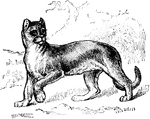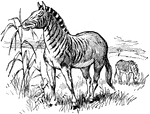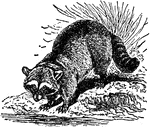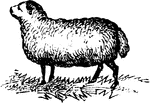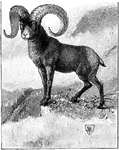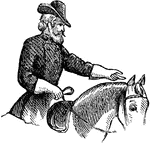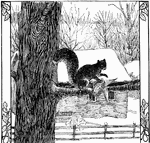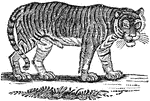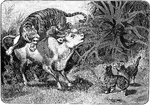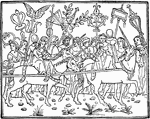
Pug Dog
The pug is a breed of small, short-haired lap dogs, probably of Oriental origin, and introduced into…

Common Raccoon
An American plantigrade carnivorous mammal, the common raccoon being the Procyon lotor. It is about…

Procyon Lotor Raccoon
"The Raccoon, or Racoon, is a handsome animal, about the size of a large cat, brown furry hair, tail…

Hispid Cotton Rat
The Hispid Cotton Rat (Sigmodon hispidus) is a small rodent in the Cricetidae family of New World rats…

Reindeer
Also known as the caribou. It is part of the deer family, commonly found in the Artic and Subartic.

The Respiratory System of a Small Mammal
The respiratory apparatus of other mammals is similar to humans in both structure and function. The…

Rhinoceros Bicornis
"Rhinoceros Atelodus, with two well-marked species, peculiar to Africa. Incisors rudimentary or wanting,…

Roebuck
"A Roe (Capreolus caprea) is a small species of deer inhabiting Europe and some parts of Western Asia.…

Dorsal View of the Scapula of a Rabbit
An illustration of the dorsal view of the scapula of a rabbit. "A, acromion; m, metacromion; g, glenoid…

The Seal
"The seal, adapted principally for water. The extremities are larger than in the porpoise and manatee."—Pettigrew,…

Elephant Seal on a Rock
"The seal Macrorhinus elephantinus or proboscideus, or Morunga proboscidea. It is the largest of the…
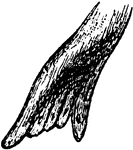
Foot of Seal
"Foot of the seal, which opens and closes in the act of natation, the organ being folded upon itself…

Hooded Seal
"The Seal, of the family Phocidæ, or seal tribe, are, of all four-limbed mammiferous animals,…

Leg of Seal
This illustration shows the leg of a seal. P. Pelvis, FE. Femur, TI. Tibia, FI. Fibula, TA. Tarsus,…

Leopard Seal
Leptonychotes weddelli. "A spotted seal of the southern and antarctic seas, belonging to the family…
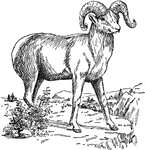
Bighorn Sheep
The bighorn is a wild sheep of the Rocky Mountains known to frequent the craggiest of rocks.

Shrew
Shrews are small, superficially mouse-like mammals of the family Soricidae. Although their external…
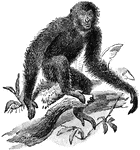
Siamang
The Siamang (Symphalangus syndactylus) is an ape in the Hylobatidae family of gibbons. It is distinguished…

Lower Jaw of Megatherium Fossil Skeleton
The lower jaw and teeth of the Megatherium, elephant sized sloth. The teeth are quandrangular, or triangular…

Full Megatherium Fossil Skeleton
A full fossil skeleton of the Megatherium, an elephant sized ground sloth. The animal was extinct during…
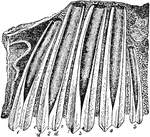
Upper Molar Teeth of Megatherium Fossil Skeleton
Illustration showing the upper molar teeth of the megatherium, a giant sloth. The teeth were 7 to 8…
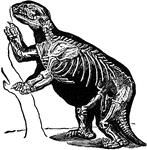
Giant Sloth
"Sloth is the popular name for any individual of the Edentate group Tardigrada, from their slow and…

Smooth-coated Fox-terrier
The Fox-terrier is not an old breed, only dating back about a century; but the fox-terrier's cleverness,…

Squirrel Wearing Robe and Holding Candle Near Bed
An illustration of a squirrel wearing a robe and holding a candle standing near a four poster bed.
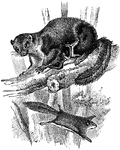
Smoky Flying Squirrel
The Smoky Flying Squirrel (Pteromyscus pulverulentus) is a species of rodent in the Squirrel (Sciuridae)…
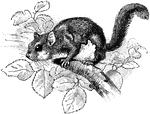
American Flying Squirrel
The American Flying Squirrel (Sciuropterus volucella) is a small rodent in the Sciuridae family of squirrels.
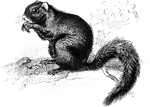
Black Fox Squirrel
The Fox Squirrel (Sciurus niger) is a rodent in the Sciuridae family of squirrels. The black fox squirrel…

Eastern Gray Squirrel
The Eastern Gray Squirrel (Sciurus carolinensis) is a tree squirrel native to eastern United States.
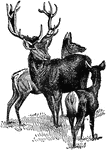
Stag
"Stag, or Red Deer, is a typical species of deer, occurring in the N. of Europe and Asia. It was once…
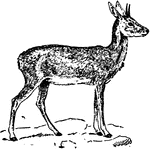
Steinbok
"A small (under two feet) South and East African antelope, in which the horns of the male rarely exceed…

Tasmanian Devil
The Tasmanian Devil (Sarcophilus harrisii) is a carnivorous marsupial native to Tasmania, Australia.

Tenrec
"Tenrec is a genus of Insectivora, represented by one species, which is restricted to Madagascar, Bourbon,…

Tinoceras
"Tinoceras, or tinotherium, is a genus of mammals now extinct, found in the Eocene, and representing…

Vicuna
The vicuna is the smallest member of the camel family. It lives in elevated locations in South America.
